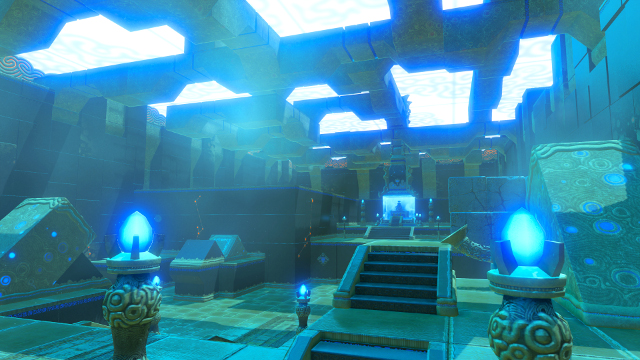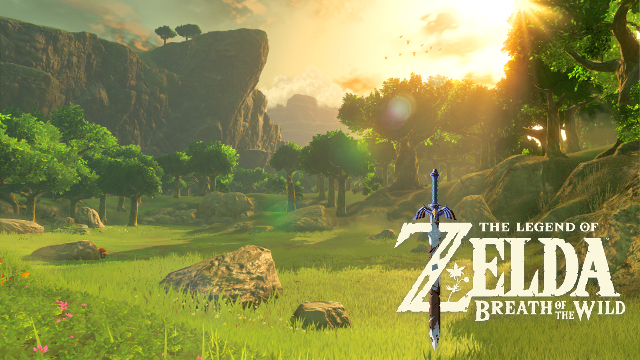Most of the 20+ hours I've spent using my Nintendo Switch have been while playing The Legend of Zelda: Breath of the Wild. Some of that is because there isn't a whole lot to do with the Switch right now since online functionality is disabled, but most of it is because Breath of the Wild is a fantastic game.
Reading the title of this article, I'm sure you're probably thinking I'm crazy for comparing a Zelda game to two indie titles, but bear with me. This is a fresh Zelda game unlike anything the series has ever seen before, invoking a more dramatic shift in design than motion controls ever did for Skyward Sword.
During this hands-on preview I want to talk about general impressions I've had playing the game so far, focusing on two particular elements that I would consider to be the pillars of gameplay, all while avoiding spoilers. Let's get started.
Into the Wild
This was it. This was the moment I had been waiting for. Not only was I playing the Zelda that I vividly remember Nintendo showing back in 2014, but I was playing a full-scale AAA title from the series on a handheld device. The Switch's handheld mode would become my primary means of enjoying the experience over time, as I would find that there is something special about being able to take Zelda with me no matter where I am.
After a brief and predictable introduction I was cast into the sunlight once again as Link in what is officially his 18th story of heroism and determination.

I've played plenty of Zelda games before, but the first time I was able to bear witness to the open world of Breath of the Wild was something to remember. This is a beautiful game, and for one reason or another it appeared familiar. I would soon find out why.
Puzzle Solving
The first order of business was finding a shrine. Shrines are essentially Breath of the Wild's version of the dungeon, something Zelda has kept around for 30 years. Though they function similarly, there are some key differences. The most important distinction is that shrines are short. Not relatively short, or kind of short, but short. Players can often complete them in fewer than 10 minutes when they're lucky or gifted with problem-solving.
Each Shrine tends to focus on one style of puzzle, whether it be utilizing a new Rune (special ability) that Link's earned, or finding a way to make me think outside the box about how to interact with the environment. The puzzles are usually incredibly clever, making me wonder how the developer came up with so many ideas.
Although the brevity of the shrines might make it appear that puzzles have been de-emphasized in Breath of the Wild, that's definitely not the case. There are actually over 100 Shrines scattered throughout the world, and it didn't take long for me to notice that I was spending a great deal of time traveling from one Shrine to the next.
The Witness was actually very similar in this regard. Although players were solving line puzzles rather than interacting with full 3D environments, the game flow of completing quick puzzle sections with travel in-between is a quality that both games share. And just like in The Witness, I've spent a lot of time trying to figure out where the next puzzle is in Breath of the Wild. This new Zelda game will not hold a hand, and over time I've learned to celebrate the finding of each Shrine.

With that, in Breath of the Wild I have spent most of my time in the outdoors frolicking about. When doing so I've noticed that there is a great amount of landscape variety, perhaps the most appealing of which are the open grasslands where grass sways with the wind as birds chirp in the background. Once again, Breath of the Wild reminds me of The Witness in many of these environments, with its surprisingly similar art style that's colorfully represents the beauty of our real world.
Survival Of the Fittest
I enjoy puzzles, but that's not usually why I play a Zelda game. Thankfully, completing Shrines isn't the only thing I've done in Breath of the Wild. There's a heavy helping of combat, and perhaps more importantly survival gameplay. Put simply, it's impossible to survive the journey from beginning to and without hunting and gathering.
This is best illustrated by the weapon design. Unlike prior Zelda games, I haven't been able to stick to one reliable weapon for any length of time, as they break quite quickly with use. As a result of this, it's been important to gather new weapons from enemies and loot to protect myself when confronted.
I wish I could say I enjoy the combat. It's not that it's bad, it's just boring, especially when compared to some recent games like Nioh. There aren't a whole lot of different interactions to employ when engaged with an enemy, and that's resulted in me avoiding a lot of battles in the long run. The only winner here is the variety of weaponry, which makes collecting an arsenal a worthwhile endeavor. This becomes far less of an issue during boss battles, which introduce enough technical complexity as to make a small amount of inputs enough to be exciting.
In addition to combat, cooking is an essential part of survival. There are no more hearts to gather in the open game world that will heal Link without effort. Instead, I've learned to constantly gather resources, from mushrooms to raw meat, before cooking them at a campfire. This portion of the game is rather complex, presenting hundreds of possible recipe combinations that play an instrumental part of breaking through the often times intense challenge that Breath of the Wild presents.

You might have gotten the impression from previews that these survival oriented gameplay elements are something you'll occasionally do. The truth is that they make up a lion's share of the game. I know that I have spent more time gathering and cooking than fighting enemies, which is a drastic change from prior games.
There are times I've felt like I'm playing a survival game, most notably Don't Starve. I've evolved to constantly be looking for useful materials in the environment, and those materials are no longer hearts or rupees. I then ponder for a couple minutes about what to make as if I'm Gordon Ramsay.
These survival elements come together to make it really feel like I'm fighting for my life. On numerous occasions I've spent a few minutes trying to find and gather useful items, stocking up on weapons and food as if I'm preparing for 2012. It's kind of fun doing so, and it is always worth it later when I find myself in a tough situation, which there are plenty of in my experience.
Closing Thoughts
I really like the way Breath of the Wild feels, but there have been times that frustration kicks in. I've felt lost a multitude of times, which I was expecting, but not to this degree. Sometimes I just want to get on with it, and any time that climbing is involved I feel like attaching a rubber band to my left joystick and taking a break.
This is unlike any Zelda game I've ever played, but even then I feel like I've played it before. It shares qualities with other great games in the puzzle and survival universes that similarly produced frustration, but in the end were always worth spending time with. I really wasn't expecting that, and it's a nice treat.

Check Out More The Legend of Zelda: Breath of the Wild Coverage:







